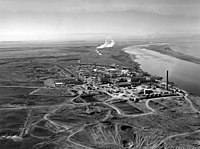
Photo from wikipedia
Hard crusts on aging plutonium production waste have hindered the remediation of the Hanford Site in southeastern Washington, USA. In this study, samples were analyzed to determine the cause of… Click to show full abstract
Hard crusts on aging plutonium production waste have hindered the remediation of the Hanford Site in southeastern Washington, USA. In this study, samples were analyzed to determine the cause of a hard crust that developed on the highly radioactive sludge during 20 years of inactivity in one of the underground tanks (tank 241-C-105). Samples recently taken from the crust were compared with those acquired before the crust appeared. X-ray diffraction and scanning electron microscopy (SEM) indicated that aluminum and uranium phases at the surface had converted from (hydr)oxides (gibbsite and clarkeite) into carbonates (dawsonite and cejkaite) and identified trona as the cementing phase, a bicarbonate that formed at the expense of thermonatrite. Since trona is more stable at lower pH values than thermonatrite, the pH of the surface decreased over time, suggesting that CO2 from the atmosphere lowered the pH. Thus, a likely cause of crust formation was the absorption of CO2 from the air, leading to a reduction of the pH and carbonation of the waste surface. The results presented here help establish a model for how nuclear process waste can age and can be used to aid future remediation and retrieval activities.
Journal Title: Journal of hazardous materials
Year Published: 2018
Link to full text (if available)
Share on Social Media: Sign Up to like & get
recommendations!